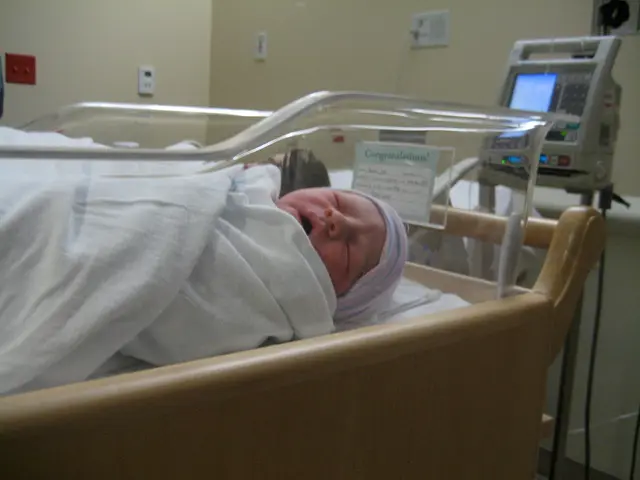Medical Emergency: Signs, Roots, and Remedies for Appendix Rupture
Appendicitis, a common medical condition, requires immediate attention due to its potential severity. This article aims to provide an overview of this condition, its symptoms, treatment, and prevention.
Appendicitis typically affects individuals during their teenage years or twenties and is the most common cause of acute abdominal pain requiring surgery in the United States. The appendix, a small finger-shaped pouch on the right side of the abdomen, can become swollen, inflamed, and filled with pus when appendicitis occurs.
The first symptom of appendicitis is usually severe and sudden pain in the abdomen, often beginning near the belly button and then moving lower and to the right. Other signs and symptoms may include loss of appetite, nausea, vomiting, fever, constipation or diarrhea, swelling in the abdomen, and pain around the middle of the belly near the belly button in children.
A burst appendix, or a ruptured appendix, is a serious medical condition that requires immediate attention. Symptoms of a ruptured appendix may include sudden, severe abdominal pain, fever and chills, nausea and vomiting, swelling and bloating, inability to pass gas, rapid heartbeat, mental confusion or weakness, and a hard, tender stomach. These symptoms can lead to complications such as sepsis, a potentially life-threatening infection.
Diagnosing appendicitis accurately and efficiently can reduce complications. Doctors may use a physical exam, imaging tests, and a review of symptoms and medical history to make a diagnosis. They may also request urine analysis, pregnancy test, blood tests, and a C reactive protein test to rule out other possibilities.
The standard treatment for appendicitis is an appendectomy, a surgery to remove the inflamed appendix before it bursts. This can be done through laparotomy surgery, where the surgeon makes a single incision in the lower right area of the abdomen, or laparoscopic surgery, where the surgeon makes several small incisions and uses special surgical tools.
In some situations, the surgeon may find an appendix that appears normal, and they will likely still remove it to eliminate the possibility of appendicitis and its potential future bursting. Delaying surgery may increase the risk of complications, but complications after quick surgery are usually rare.
Recovery from an appendectomy usually takes a short time, and most people will completely recover from appendicitis. However, the risk of appendix rupture increases by about 5% every 12 hours after the onset of symptoms, and it is approximately 50% after 36 hours. Therefore, speaking to a doctor as soon as possible if symptoms of appendicitis are suspected can prevent the appendix from bursting.
Before the introduction of surgical treatment, more than half of people with appendicitis died, but with surgical treatment, the mortality rate has been reduced significantly. Today, about 1 in 1000 people may die from appendicitis.
In conclusion, understanding the symptoms, treatment, and prevention of appendicitis is crucial for prompt medical attention and a successful recovery. If you experience symptoms of lower right side abdominal pain, nausea, and fever, consult a doctor immediately.
- In addition to appendicitis, type 2 diabetes, a chronic disease, is also prevalent, particularly in individuals affected by obesity and depression.
- Rheumatoid arthritis is another autoimmune disorder that affects joints, causing pain and inflammation, and often accompanied by depression and other mental-health issues.
- Abdominal pain can also be a symptom of irritable bowel syndrome (IBS), a common digestive-health condition.
- Predictive analytics in science can help identify individuals at risk of developing chronic diseases, such as diabetes, cardiovascular-health problems, and certain cancers.
- Sleep disorders, like sleep apnea, can lead to conditions like obesity, diabetes, and cardiovascular-health issues.
- Employee wellness programs in the workplace-wellness sector aim to reduce the prevalence of medical-conditions like obesity, diabetes, and mental-health issues among employees.
- Neurological disorders, such as Parkinson's disease and multiple sclerosis (MS), can affect hearing, eye-health, and motor skills, in addition to causing cognitive impairment.
- Respiratory conditions like asthma and chronic obstructive pulmonary disease (COPD) can cause breathing difficulties, and may also lead to pneumonia, a potential threat to femenine and men's health.
- Skin conditions like psoriasis and eczema can cause painful and itchy rashes, while more severe skin-conditions like melanoma, a type of skin cancer, require immediate medical attention.
- Urological issues, such as kidney stones and prostate problems, can cause pain in the abdomen and lower back, requiring medical evaluation and potential therapies-and-treatments.
- Neurological disorders, such as epilepsy and migraines, can greatly impact mental-health, leading to depression and anxiety.
- Aging brings about a decline in various health-and-wellness aspects, including fitness-and-exercise ability, sexual-health, mental-health, and even eye-health and hearing.
- Sexual-health is also crucial in womens-health, including reproductive health, and in mens-health, including prostate health and sexually-transmitted infections (STIs).
- Parenting, especially single parenting, can be stressful, leading to depression, anxiety, and other mental-health issues.
- Weight-management is vital in preventing obesity, diabetes, cardiovascular-health problems, and other chronic diseases.
- Certain medications and nutritional factors can have adverse effects on skin-care, causing dryness, rashes, or other skin-conditions.
- Aging and certain medications can also have negative impacts on cardiovascular-health, leading to heart disease and stroke.
- Medicare, a federal health insurance program for people aged 65 and older, covers many treatments and therapies for chronic diseases, cancer, and other medical-conditions.
- Some alternative treatments, like CBD oil, have shown potential in relieving pain, anxiety, and other symptoms associated with various medical-conditions, but further research is needed for conclusive evidence.




